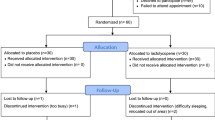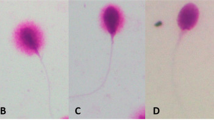Abstract
The effects of supplementation with docosahexaenoic acid (DHA) on DHA levels in serum, seminal plasma, and sperm of asthenozoospermic men as well as on sperm motility were examined in a randomized, double-blind, placebo-controlled manner. Asthenozoospermic men (n=28; ≤50% motility) were supplemented with 0, 400, or 800 mg DHA/d for 3 mon. Sperm motility and the fatty acid composition of serum, seminal plasma, and sperm phospholipid were determined before and after supplementation. In serum, DHA supplementation resulted in decreases in 22∶4n−6 (−30% in the 800-mg DHA group only) and total n−6 (−6 and −12% in the 400- and 800-mg DHA groups, respectively) fatty acids. Increases were noted in DHA (71 and 131% in the 400- and 800-mg DHA groups, respectively), total n−3 fatty acids (42 and 67% in the 400- and 800-mg DHA groups, respectively), and the n−3/n−6 ratio (50 and 93% in the 400- and 800-mg DHA groups, respectively). In seminal plasma, DHA supplementation resulted in a decrease in 22∶4n−6 (−31% in the 800-mg DHA group only) and an increase in the ratio of n−3 to n−6 (35 and 33% in the 400- and 800-mg DHA groups, respectively). There were insignificant increases in DHA and total n−3 fatty acids. In sperm, decreases were noted in 22∶4n−6 (−37 and −31% in the 400-and 800-mg DHA groups, respectively). There were no other changes. There was no effect of DHA supplementation on sperm motility. The results show that dietary DHA supplementation results in increased serum- and possibly seminal plasma—phospholipid DHA levels, without affecting the incorporation of DHA into the spermatozoa phospholipid in asthenozoospermic men. This inability of DHA to be incorporated into sperm phospholipid is most likely responsible for the observed lack of effect of DHA supplementation on sperm motility.
Similar content being viewed by others
Abbreviations
- DHA:
-
docosahexaenoic acid
- DPA:
-
docosapentaenoic acid
- EPA:
-
eicosapentaenoic acid
- GLM:
-
general linear model
- α-LNA:
-
α-linolenic acid
- MDA:
-
malondialdehyde
- PC:
-
phosphatidylcholine
- PE:
-
phosphatidylethanolamine
References
Beauchamp, P.J., Galle, P.C., and Blasco, L. (1984) Human Sperm Velocity and Post Insemination Cervical Mucous Test in the Evaluation of Infertile Couple,Arch. Androl. 13, 107–112.
Bongso, T.A., Ng, S.C., Mok, H., Lim, M.N., Teo, H.L., Wong, P.C., and Ratnam, S.S. (1989) Effect of Sperm Motility on Humanin vitro Fertilization,Arch. Androl. 22, 185–190.
Nissen, H.P., and Kreysel, H.W. (1983) Superoxide Dismutase in Human Semen,Klin. Wochensch. 61, 63–65.
Alvarez, J.G., and Storey, B.T. (1983) Role of Superoxide Dismutase in Protecting Rabbit Spermatozoa from O2 Toxicity Due to Lipid Peroxidation,Biol. Reprod. 28, 1129–1136.
Alvarez, J.G., and Storey, B.T. (1992) Evidence for Increased Lipid Peroxidative Damage and Loss of Superoxide Dismutase Activity as a Mode of Sublethal Cryo-Damage to Human Sperm During Cryopreservation,J. Androl. 13, 232–241.
Weinberg, J.B., Doty, E., Bonaventura, J., and Haney, A.F. (1995) Nitric Oxide Inhibition of Human Sperm Motility,Fertil. Steril. 64, 408–413.
Griveau, J.F., and Le Lannou, D. (1997) Reactive Oxygen Species and Human Spermatozoa: Physiology and Pathology,Int. J. Androl. 20, 61–69.
Tanphaichitr, N., Zheng, Y.S., Kates, M., Abdullah, N., and Chan, A. (1996) Cholesterol and Phospholipid Levels of Washed and Percoll Gradient Centrifuged Mouse Sperm: Presence of Lipids Possessing Inhibitory Effects on Sperm Motility,Mol. Reprod. Devel. 43, 187–195.
Hula, N.M., Tron'ko, M.D., Volkov, H.L., and Marhitych, V.M. (1993) Phospholipids of Human Seminal Plasma and Their Role in Ensuring Fertility,Ukr. Biokhim. Zh. 65, 75–78.
Hong, C.Y., Shieh, C.C., Wu, P., Huang, J.J., and Chiang, B.N. (1986) Effect of Phosphatidylcholine, Lysophosphatidylcholine, Arachidonic Acid and Docosahexaenoic Acid on the Motility of Human Sperm,Int. J. Androl. 9, 118–122.
Nissen, H.P., and Kreysel, H.W. (1983) Polyunsaturated Fatty Acids in Relation to Sperm Motility,Andrologia 15, 264–269.
Gulaya, N.M., Tronko, M.D., Volkov, G.L., and Margitich, M. (1993) Lipid Composition and Fertile Ability of Human Ejaculate,Ukr. J. Biochem. 65, 64–70.
Zalata, A.A., Christophe, A.B., Depuydt, C.E., Schoonjans, F., and Comhaire, F.H. (1998) The Fatty Acid Composition of Phospholipids of Spermatozoa from Infertile Patients,Mol. Hum. Reprod. 4, 111–118.
Conquer, J., Martin, J.B., Tummon, I., Watson, L., and Tekpetey, F. (1999) Fatty Acid Analysis of Blood Serum, Seminal Plasma and Spermatozoa of Normozoospermic vs. Asthenozoospermic Males,Lipids 34, 793–799.
Jones, R.E., and Plymate, S.R. (1993) Synthesis of Docosahexaenoyl Coenzyme A in Human Spermatozoa,J. Androl. 14, 428–432.
Jones, R.E., and Plymate, S.R. (1988) Evidence for the Regulation of Fatty Acid Utilization in Human Sperm by Docosahexaenoic Acid,Biol. Reprod. 39, 76–80.
Oliw, E.H., and Sprecher, H.W. (1991) Metabolism of Polyunsaturated (n−3) Fatty Acids by Monkey Seminal Vesicles: Isolation and Biosynthesis of n-3 Epoxides,Biochim. Biophys. Acta 1086, 287–294.
Connor, W.E., Lin, D.S., Wolf, D.P., and Alexander, M. (1998) Uneven Distribution of Desmosterol and Docosahexaenoic Acid in the Heads and Tails of Monkey Sperm,J. Lipid Res. 39, 1404–1411.
Suleiman, S.A., Elamin Ali, M., Zaki, M.S., El-Malik, E.M.A., and Nasr, M.A. (1996) Lipid Peroxidation and Human Sperm Motility: Protective Role of Vitamin E,J. Androl. 17:530–537.
Knapp, H.R. (1990) Prostaglandins in Human Semen During Fish Oil Ingestion: Evidence forIn Vivo Cyclooxygenase Inhibition and Appearance of Novel Trienoic Compounds,Prostaglandins 39, 407–423.
Kelso, K.A., Cerolini, S., Noble, R.C., Sparks, N.H.C., and Speake, B.K. (1997) The Effects of Dietary Supplementation with Docosahexaenoic Acid on the Phospholipid Fatty Acid Composition of Avian Spermatozoa,Comp. Biochem. Physiol. 118B, 65–69.
Kelso, K.A., Cerolini, S., Speake, B.K., Cavalchini, L.G., and Noble, R.C. (1997) Effects of Dietary Supplementation with Alpha-Linolenic Acid on the Phospholipid Fatty Acid Composition and Quality of Spermatozoa in Cockerel from 24 to 72 Weeks of Age,J. Reprod. Fertil. 10, 53–59.
Blesbois, E., Lessire, M., Grasseau, I., Hallouis, J.M., and Hermier, G. (1997) Effect of Dietary Fat on the Fatty Acid Composition and Fertilizing Ability of Fowl Semen,Biol. Reprod. 56, 1216–1220.
Paulenz, H., Taugbol, O., Hofmo, P.O., and Saarem, K. (1995) A Preliminary Study on the Effect of Dietary Supplementation with Cod Liver Oil on the Polyunsaturated Fatty Acid Composition of Boar Semen,Vet. Res. Commun. 19, 273–284.
Christophe, A., Zalata, A., Mahmoud, A., and Combaire, F. (1998) Fatty Acid Composition of Sperm Phospholipids and Its Nutritional ImplicationsMiddle East Fertil. Soc. J. 3, 46–53.
Mortimer, D. (1985) The Male Factor in Infertility Part II. Sperm Function Testing,Curr. Prob. Obstet. Gynecol. Fertil. 8, 75 pp. Year Book Medical Publishers, Chicago.
Conquer, J.A., and Holub, B.J. (1997) Effect of Supplementation with DHA on Lipid/Lipoprotein Levels in Subjects of Asian Indian Background,J. Lipid Res. 39, 286–292.
World Health Organization (1992)WHO Laboratory Manual for the Examination of Human Semen and Semen-Cervical Mucus Interactions, pp. 9–15, Cambridge University Press, Cambridge.
Ma, J., Folsom, A.R., Eckfeldt, J.H., Lewis, S.L., and Chambless, L.E. (1995) Short- and Long-Term Repeatability of Fatty Acid Composition of Human Plasma Phospholipids and Cholesterol Esters,Am. J. Clin. Nutr. 62, 572–578.
Bonaa, K.H., Bjerve, K.S., and Nordoy, A. (1992) Habitual Fish Consumption, Plasma Phospholipid Fatty Acids, and Serum Lipids: The Tromsø Study,Am. J. Clin. Nutr. 55, 1126–1134.
Nikkari, T., Luukkainen, P., Pietinen, P., and Buska, P. (1995) Fatty Acid Composition of Serum Lipid Fractions in Relation to Gender and Quality of Dietary Fat,Ann. Med. 27:491–498.
Conquer, J.A., and Holub, B.J. (1997) Dietary Docosahexaenoic Acid as a Source of Eicosapentaenoic Acid in Vegetarians and Omnivores,Lipids 32, 341–345.
Conquer, J.A., and Holub, B.J. (1996) Effect of Supplementation with an Algae Source of Docosahexaenoic Acid on n-3 Status and Risk Factors for Heart Disease in Vegetarians,J. Nutr. 126, 3032–3039.
Aitken, R.J. (1995) Free Radicals, Lipid Peroxidation and Sperm Function,Reprod. Fertil. Dev. 7, 659–668.
Mitropoulos, D., Deliconstantinos, G., Zervas, A., Villiotou, V., Dimopoulos, C., and Stavrides, J. (1996) Nitric Oxide Synthase and Xanthine Oxidase Activities in the Spermatic Vein of Patients with Varicocele: A Potential Role for Nitric Oxide and Peroxynitrite in Sperm Dysfunction,J. Urol. 156, 1952–1958.
Alkan, I., Simsek, F., Goncagul, H., Kervancioglu, E., Ozveri, H., Yalcin, S., and Akdas, A. (1997) Reactive Oxygen Species Production by the Spermatozoa of Patients with Idiopathic Infertility: Relationship to Seminal Plasma Antioxidants,J. Urol. 157, 140–143.
Lewis, S.E.M., Sterling, E.S.L., Young, I.S., and Thompson, W. (1997) Comparison of Individual Antioxidants of Sperm and Seminal Plasma in Fertile and Infertile Men,Fertil. Steril. 67, 142–147.
Connor, W.E., Weleber, R.G., DeFrancesco, C., Lin, D.S., and Wolf D.P. (1997) Sperm Abnormalities in Retinitis Pigmentosa,Invest. Opthmol. Vis. Sci. 38, 2619–2628.
Author information
Authors and Affiliations
Corresponding author
About this article
Cite this article
Conquer, J.A., Martin, J.B., Tummon, I. et al. Effect of DHA supplementation on DHA status and sperm motility in asthenozoospermic males. Lipids 35, 149–154 (2000). https://doi.org/10.1007/BF02664764
Received:
Revised:
Accepted:
Issue Date:
DOI: https://doi.org/10.1007/BF02664764




